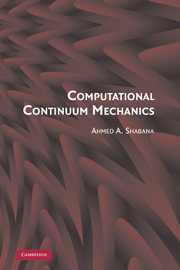5 - Plasticity Formulations
Published online by Cambridge University Press: 06 July 2010
Summary
The analysis of plastic deformation is important in many engineering applications including crashworthiness, impact analysis, manufacturing problems, among many others. When materials undergo plastic deformations, permanent strains are developed when the load is removed. Many materials exhibit elastic–plastic behaviors, that is, the material exhibits elastic behavior up to a certain stress limit called the yield strength after which plastic deformation occurs. If the stress of elastic-plastic materials depends on the strain rate, one has a rate-dependent material, otherwise the material is called rate independent. In the classical plasticity analysis of solids, a nonunique stress–strain relationship that is independent of the rate of loading but does depend on the loading sequence is used (Zienkiewicz and Taylor, 2000). In rate-dependent plasticity, on the other hand, the stress–strain relationship depends on the rate of the loading.
The yield strength of elastic–plastic materials can increase after the initial yield. This phenomenon is known as strain hardening. In the theory of plasticity, there are two types of strain hardening, isotropic and kinematic hardening. In the case of isotropic hardening, the yield strength changes as the result of the plastic deformation. In the case of kinematic hardening, on the other hand, the center of the yield surface experiences a motion in the direction of the plastic flow. The kinematic hardening behavior is closely related to a phenomenon known as the Bauschinger effect, which is the result of a reduction in the compressive yield strength following an initial tensile yield.
- Type
- Chapter
- Information
- Computational Continuum Mechanics , pp. 177 - 230Publisher: Cambridge University PressPrint publication year: 2008



